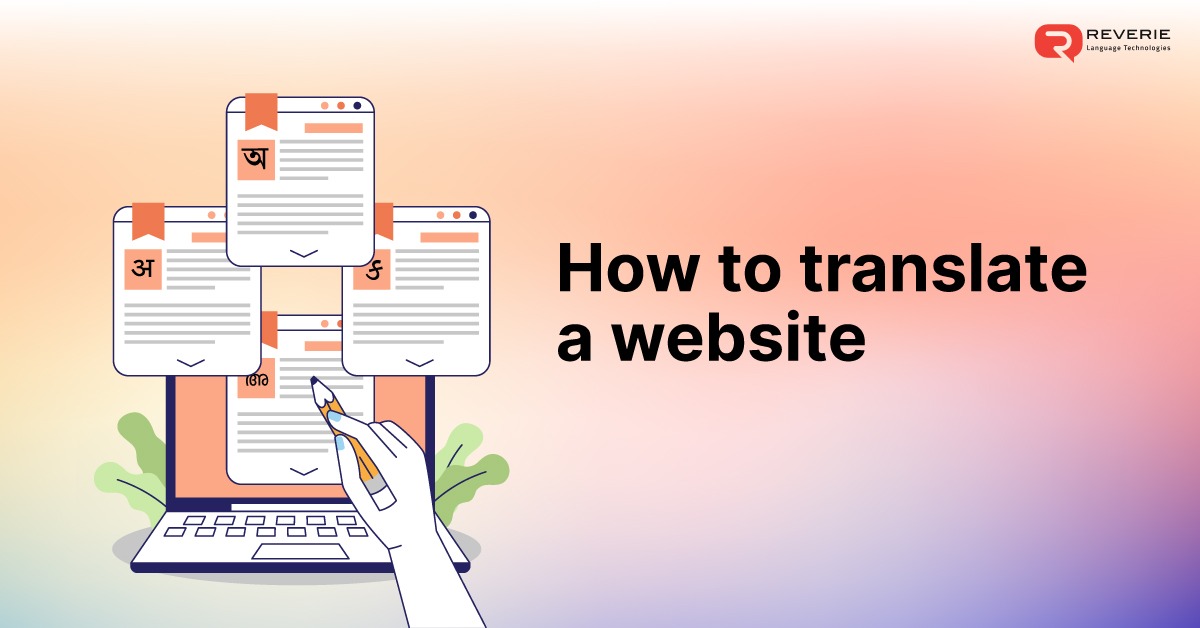In a culturally and linguistically diverse country like India, it’s imperative for businesses to focus on connecting and making a deep connection with the local audience to have a strong footing. The Eight Schedule of the Indian Constitution acknowledges 22 languages as official languages of India. Demands to add more languages like Bhojpuri, Rajasthani, and more to the list are also being made. Moreover, 90% of Indian users on the Internet prefer consuming digital content in native languages.
Businesses must connect with their audience in their native language to stay relevant and get a larger market share. By leveraging website translation and localisation services businesses can establish a meaningful connection with their audience.
Picture this, a customer visits your website but can’t understand the language that the website is created in. They will not be able to navigate through the website. Fortunately, there are various ways to translate the website online to make it more accessible to them.
In this article, we are going to discuss how website translation can help your business grow. We will also discuss different ways to translate a website.
Website Translation: What's in It for Me?
Translating your website into multiple languages can be a strategic approach to growing your business. If you are a business looking to expand into a linguistically diverse marketplace, then translating your website should be a part of your strategy.
It comes with a number of benefits that can have a major impact on your business growth and customer engagement. Here are a few key benefits of website translation:
Better SEO Performance
Every business is in the race to be on the top of search engine result pages (SERPs). Translating your website’s content can help you in catering to regional SEO (Search Engine Optimisation) strategies.
It can help you boost your visibility in local search results. Search engines, like Google, give preference to content that resonates well with the user’s language and location. So, translating your website can help you rank higher and increase traffic to your website.
Reaching Local Audience
One of the biggest advantages of website translation in a country like India is that you can reach and connect with the local audience. With your website available in multiple Indian languages, you can easily target the audience in that region.
For instance, users who speak and read Tamil will feel more connected to content in the Tamil language. Similarly, people who speak and read Punjabi will appreciate the content in Punjabi.
Improved User Experience
Websites that speak the local language resonate with the end user leading to a more engaged user experience. This can help in reducing bounce rates and increasing the time spent on the site. Both the outcomes are positive signals to search engines, which can help in improving overall site performance as well. This also gives you a competitive advantage over your competitors who create content in just one language.
One prime example of this is Zomato, an online food delivery service. Zomato, in 2022, announced that the app will be available in various regional languages, including:
- Hindi
- Gujarati
- Kannada
- Bengali
- Malayalam
- Punjabi
- Marathi
- Tami
- Telugu
According to Zomato, in 2022, Zomato was delivering more than 1,50,000 orders in a month. Hindi contributed 54% of these orders, and Tamil contributed 11%. The contribution from the rest of the languages was growing as well. The same year, the platform witnessed a notable 62.2% jump in revenue, which went up to Rs 1661 Cr. from Rs 1,024 Cr. in the previous year.
Cultural Relevance
Our native languages tie us to our culture and give us a sense of belonging. While translation is just about translating the text, localisation goes beyond that. It also involves adapting the cultural nuances, idioms, and context that resonate with the local audience.
For example, the straightforward translation of a greeting like “hello” in Hindi will be नमस्ते (Namaste). However, when you’re targeting a particular region or area, using local idioms, phrases, and slang can make the content more relatable. Using slang like “ನಮ್ಮ ಬೆಂಗಳೂರು” (Namma Bengaluru) instead of mere translations to target your audience in Bengaluru can enhance the user’s experience.
This helps in fostering trust and credibility among the target audience. Businesses that show understanding and respect for local culture can witness enhanced brand loyalty and customer retention.
Return on Investment (ROI)
Investing in website translation can lead to a substantial return on your investment. Reports show that translating websites can help companies increase their revenue. Once you make your site accessible in multiple local languages, you tap into new marketing that was previously unreachable. Thanks to this expansion, you can increase your sales, and hence, you increase your ROI.
Different Ways to Translate a Website
Translating the entire website can be a complex process. Fortunately, there are ways that simplify this process. Two primary ways to translate a website include:
- Human translation
- Machine translation
Human Translation
The first way to translate a website is by using human translation. As the name suggests, it involves the services of a human translator. These professional human translators specialise in translating web pages from one language to another.
As long as you can find the right translator, who understands the source as well as the target language, this method will give you accurate results. All methods, however, have their own advantages and disadvantages. The biggest disadvantage of human translation is that it is often costly and time-consuming.
Machine Translation
The second method to translate a website is by using machine translation. This alternative to human translation can be highly effective in translating an entire website. Also called as automated translation, it uses artificial intelligence (AI), such as Google Translate, to translate web pages from one language to another.
Machine translation is often more cost-effective and quicker than human translation. However, it may not be as accurate as the former. This is why Reverie recommends the third approach – the hybrid of human and machine translation.
Hybrid Approach
This approach involves the best aspects of both human and machine translation. First, the content is translated using sophisticated machine translation tools.
Then, it is reviewed, edited, and polished by a human translator to ensure accuracy, cultural relevance, and contextual appropriateness. This approach is not only more accurate than machine translation but also more efficient.
Reverie for Accurate Translation and Localisation
Whether you are going for website translation or localisation, choosing the right technology partner is crucial. Reverie’s products and APIs stand out as robust solutions that are tailored to India’s linguistically diverse landscape.
Reverie’s Translation API employs Neural Machine Translation (NMT) technology to offer contextually appropriate and culturally relevant translations. It is designed to translate your digital assets into 22 official Indian languages. It helps you deliver consistent brand messaging in various languages to connect with local markets.
With website localisation, you do much more than just translate your website’s content. In fact, translating is the first step towards website localisation. Localisation enables you to adapt your website to suit the local audience that you are targeting. Reverie’s Anuvadak does not just localise your website. It also manages the entire lifecycle of website localisation.
The Bottom Line
Translating and localising your website can help you reach your target audience and connect with them. It helps you establish a local presence and gain a competitive advantage. While human and machine translations can translate the content on your website, the hybrid approach ensures better accuracy and cost-effectiveness.
Reverie offers an end-to-end solution for businesses looking to expand and grow in the Indian marketplace. It empowers businesses to embrace the linguistic diversity of a country like India, effectively and efficiently. To learn more about Reverie and its products, get in touch with our experts or book a demo by clicking here!



